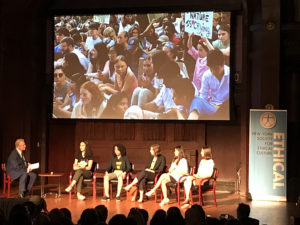Humanist EDge: We Need More Climate Education
 Panel at “Choose Us: Youth Climate Strike Demands Solutions and Action Now!” at New York Society for Ethical Culture on Monday, September 23, 2019, includes (left to right) Al Gore, Jamie Margolin, Naomi Hollard, Sophie Anderson, Xiye Bastida, and Alexandria Villaseñor.
Panel at “Choose Us: Youth Climate Strike Demands Solutions and Action Now!” at New York Society for Ethical Culture on Monday, September 23, 2019, includes (left to right) Al Gore, Jamie Margolin, Naomi Hollard, Sophie Anderson, Xiye Bastida, and Alexandria Villaseñor. More than a decade ago, former Vice President Al Gore gave the keynote address when I graduated from Carnegie Mellon University. He praised the school and the city of Pittsburgh for their impressive environmental accomplishments but warned us there was much more work to be done:
There is an African proverb that says if you want to go quickly, go alone. If you want to go far, go together. We have to go far, quickly. And we need your help to do it.
Last week, on September 23, I was fortunate to hear Gore again at the packed “Choose Us: Youth Climate Strike Demands Solutions and Action Now!” event hosted by the New York Society for Ethical Culture (you can watch the whole event here). Again, he shared recent climate successes—like making clean energy more affordable around the world—and detailed the challenges ahead—like keeping the US in the Paris Agreement. As much as I enjoyed hearing from Gore, I was more impressed with how deeply he listened to the panel of five young female climate activists. Imagine what could be accomplished if more politicians listened to the scientists, the students, and the communities most harmed by the climate crisis.
Gore’s 2006 documentary An Inconvenient Truth—and its sequel—brought climate education to the general public and inspired many to take the issue more seriously. But during the panel he moderated, Sunrise Movement Fellow Naomi Hollard confessed that, as a child, the charts in the film bored her. She didn’t comprehend the consequences of climate change until she experienced a destructive hurricane on the archipelago Guadeloupe in the French Caribbean. Each panelist emphasized the importance of learning about all of the people, animals, and regions harmed by climate change, rather than only caring when catastrophe hits home. One panelist, Sophie Anderson, who is the co-national coordinator of Extinction Rebellion Youth US, also acknowledged the need for education on dealing with climate anxiety, especially for younger students. To help youth channel their frustrations into action, an interdisciplinary team of teachers in Washington, DC, is developing solution-oriented classes on climate change and hoping to establish a high school environmental literacy graduation requirement. The District’s neighbor, Maryland, already has this requirement.
The movement supporting mandatory climate education isn’t limited to the voices on the stage that day. When asked in a recent congressional hearing about how to get young people involved in climate justice, sixteen-year-old Greta Thunberg simply said: “Tell them the truth.” (While her voice wasn’t physically present on the panel, there’s no denying the impact that Thunberg’s advocacy has had on the international youth-led climate movement.) You don’t need to be a climate scientist to understand the data, but we need more than just scientists to care. Rep. Barbara Lee (D-CA) is introducing a House Resolution for climate education in all schools to emphasize that “climate change is a generational social justice, racial justice, and human rights issue.” Both the Alliance for Climate Education and the National Oceanic and Atmospheric Administration continue to add excellent climate resources for all ages online.
Education is an essential first step in mitigating the effects of this global crisis. Panelist Jamie Margolin, founder and co-executive director of Zero Hour, explained that everyone has a role to play in addressing the climate crisis:
We have to attack this crisis from every angle. Through the legal angle, through the legislative angle, through mobilizations, through education. And the same goes for education. We have to use science, we have to use art, we have to use music, and we have to use everything. This should not be a “one or the other,” this should be a “hail Mary” last approach, which is really what is it.
This message was echoed in the presentation that followed the panel. Dr. Katharine Wilkinson, vice president of communication & engagement at Project Drawdown, taught event attendees about the many ways we can reduce the production of greenhouse gases and increase their absorption into the earth. Her organization’s plans require finding solutions in electricity, food and agriculture, industry, transportation, buildings, land-based sinks, ocean-based sinks, and equality concerns. She also addressed the need for better education overall.
When women and girls have access to high-quality, inclusive education and high-quality voluntary reproductive healthcare—both of which are fundamental rights still out of reach of too many and I say that as a woman who lives in Georgia …—when girls and women are able to make choices about our lives and are able to lead, those choices and that leadership turns out to be very, very good for the planet.
Every aspect of life is impacted by climate change, so solutions must also be implemented in all aspects of life. The more clearly people understand the science, the more they comprehend the threat to humanity. In turn, they’re motivated to share that knowledge with others, find solutions, and demand action by world leaders and corporations in an effort to create a better world for us all.
